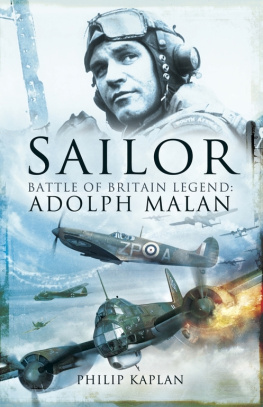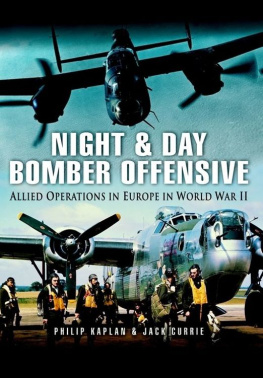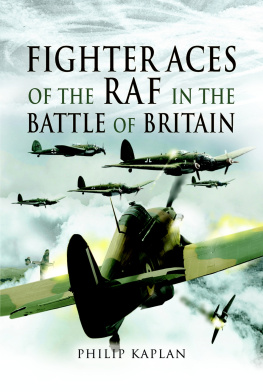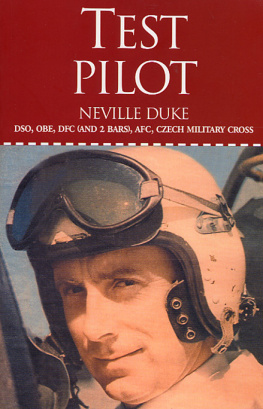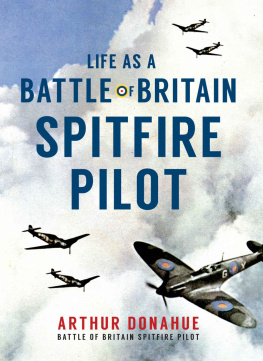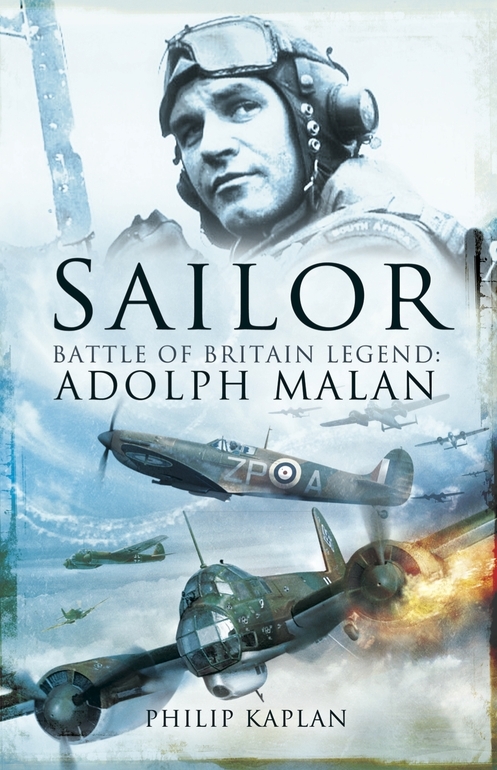BIBLIOGRAPHY
Bekker, Cajus, The Luftwaffe War Diaries , Doubleday, 1968
Bishop, Edward, The Battle of Britain , Allen and Unwin, 1960
Bungay, Stephen, The Most Dangerous Enemy , Aurum, 2009
Collier, Richard, Eagle Day , Pan Books, 1968
Deere, Alan, Nine Lives , Hodder & Stoughton, 1959
Deighton, Len, Fighter , Ballantine Books, 1977
Duke, Neville, Test Pilot , Grub Street, 2003
Forrester, Larry, Fly For Your Life , Bantam, 1978
Galland, Adolf, The First and the Last , Ballantine Books, 1954
Glancey, Jonathan, Spitfire The Biography , Atlantic Books, 2006
Hall, Roger, Clouds of Fear , Coronet Books, 1975
Hillary, Richard, The Last Enemy , Macmillan, 1950
Johnson, J.E., Wing Leader , Ballantine Books, 1957
Mason, F. K., Battle Over Britain , Alban Books
Masters, David, So Few , Eyre & Spottiswoode, 1942
Murrow, Edward R., This Is London , Simon & Schuster, 1941
Orde, Cuthbert, Pilots of Fighter Command , G. G. Harrap, 1942
Page, Geoffrey, Tale of a Guinea Pig , Wingham Press, 1991
Quill, Geoffrey, Spitfire , Arrow Books, 1985
Tidy, Douglas, I Fear No Man , Macdonald, 1972
Townsend, Peter, Duel of Eagles , Simon & Schuster, 1970 Walker, Oliver, Sailor Malan , Cassell, 1953
Wood, D. and Dempster, D., The Narrow Margin , McGraw-HillAberdeen, 167
SHOOTER
At thirty he was too old for a fighter pilot, but he became the greatest of RAF fighter pilots. Adolph Sailor Malan was not a gifted, instinctive pilot, but he became one. He was an exceptional shot, extraordinarily aggressive in air combat, a brilliant tactician, a great leader in the air, and a strict disciplinarian. Unlike many fighter pilots then and now, he was not a line-shooter or a big ego.
He devised ten commandments, his rules for air fighting, which guided and saved the lives of countless British and American fighter pilots in the Second World War and since. He had good, basic values and cared about the men in his command. He spent extra time with the newest and least experienced of them, showing them the ropes and doing all he could to keep them from making the kinds of mistakes that might get them killed.
The community of Wellington sits on the bank of the Kromme River in South Africas Western Cape, a 45-minute drive from Cape Town. Local tourism people tout its virtues in agriculture, wine and brandy-making, and point out the thrilling experience one can have on a game drive through the heart of the Cape Winelands, observing white-tailed wildebeest, springbuck, grey rhebuck and other exotic species. They call attention to the towns position as an academic centre and refer to Huguenot College as a shining example of its educational heritage.
French Huguenots had come to the area in 1694 during the reign of King Louis XIV, when religious persecution caused them to flee France for a new start in South Africa. The transplanted Huguenots shared the developing area with many Dutch settlers, starting farms in the pleasant Val du Charron, which became known as Valley of the Wagonmakers, and was the early focus of the Wellington community. Jacques Malan was the first of his family to settle on that fertile land.
The Huguenots were hard-working, practical planters, well grounded in tending, pruning and watering. Most of them, including Malan, thrived and prospered, as did their numerous descendants. One of them was Willem Malan, Willie to all who knew him in the valley. Evelyn, his wife, gave birth to their son, Adolph Gysbert, on October 3rd 1910, and the boy spent much of his early life at Slent, the family farm in the Cape. It was a time and place he always recalled fondly: The soul of South Africa lies there. The whole landscape is a painters dream, for between these enormous buttresses sustaining the southernmost end of South Africas inland plateau, are the valleys in which the first Huguenot families settled in the 1690s when the Cape settlement itself was only forty years old. I love my country and I am longing to get back there with my wife and children. It is a wonderful country for children to grow up in. The old farmstead was ideally set on the green slopes of the Paardeberg or Horse Mountain, sixteen miles south of Adolphs Wellington birthplace. The area was lush with great oaks, vineyards and fruit trees, and the spectacular Table Mountain was visible twenty miles to the south.
Throughout his boyhood Adolph was intrigued by guns and firearms, an interest encouraged by his father who, on one particular Sunday afternoon when the boy was eight years old, called him into the house and handed him a double-barrelled shotgun. Giving him a handful of cartridges, Willie said: Go and shoot something for the pot. Sailor remembered: I suppose he was joking. I was small for my age, but my father seemed to like thrusting responsibility onto me, and he must have had a purpose in doing so.
I went outside and scored a bulls eye on a watering can. That got me into trouble later. Then I tried creeping up behind a turtle-dove. How I was able to get the gun to my shoulder and fire, I dont know, but I did. Unfortunately, I fired off both barrels at once and the recoil knocked me flat and bruised my shoulder for days after. When I reloaded the gun I got the rim of one of the cartridges jammed in the breech. I struggled very hard to break the gun open, but I hadnt the strength. In the end I took it back under my arm, and ran into the lounge to my mother, still wrestling with the triggers and pointing the barrels towards her. She was terribly angry, and snatched the gun from me. I was scolded and so was my father for letting me have the gun. I wasnt allowed to handle a shotgun for a long time after that.
Two conflicts known to history as the Boer (farmer descendants of the Dutch settlers) Wars were fought in the latter part of the nineteenth century between the British and the independent Boer republics, Transvaal and the Orange Free State. The first of these, the Transvaal War of 1880-81, occurred when the Boers rebelled against British rule in the Transvaal. Then in 1899, the rooibaatjes or redcoat troops from several British possessions battled the Boers resulting in the conversion of the Boer republics into British colonies, which later became the Union of South Africa. This war lasted until 1902 and divided the loyalties of the various Malans. Willies brother Piet favoured the Boers, while Willie supported the British cause.
In the second Boer War, General Jan Christiaan Smuts led commandos against the British in attacks on their vital supply lines in the Highveld region. In one of these raids, at Twenty-four Rivers, Willie Malan was astride his horse when struck by rifle fire from one of Smuts men. The first bullet ripped through both of his thighs, shattering one of the bones. The second round opened a massive wound on his right arm. As he lay in the Wellington hospital the leg began to supperate and the medical staff debated whether to amputate. In the end Willie kept the leg, but for the next six years, he struggled around on crutches, a virtual invalid. Ultimately, he lost patience with the doctors and set about trying to cure himself of the nearly constant pain and discomfort. Eventually, he was able to ride again and do limited work on the family farm.
Growing up at Slent was a storybook adventure for Adolph and his younger brother, Ralph. Baboons still sheltered in the rocky upper reaches of the farm and, in times when food was scarce, the animals frequently came down to raid the big fig tree behind the farmhouse. The family dogs then chased the baboons who in turn chased the dogs. While amusing, this never matched the thrill the boys had in boar baiting. They were captivated by teasing a great grey beast with savage tusks and a vicious attitude, and for the rest of his life Sailor carried a scar on his arm from a close encounter in a Boar War of his own: When I exploded a clod of earth right on his snout, that boar had made up his mind to get me. Once you get a pigs mind set in one direction you never shake him off. He must have chased Ralph and me more than a mile through the orchards and out onto the mountainside before he finally caught up with me. I was winded, and so was he, but he had some steam to spare. I could feel him closing in and just managed to jump and catch hold of the branch of a tree. Unfortunately the branch broke, and I fell on his back. He carried me a couple of yards, and then, when I dropped, he swung round and tried to savage me. And thats when I got this...

